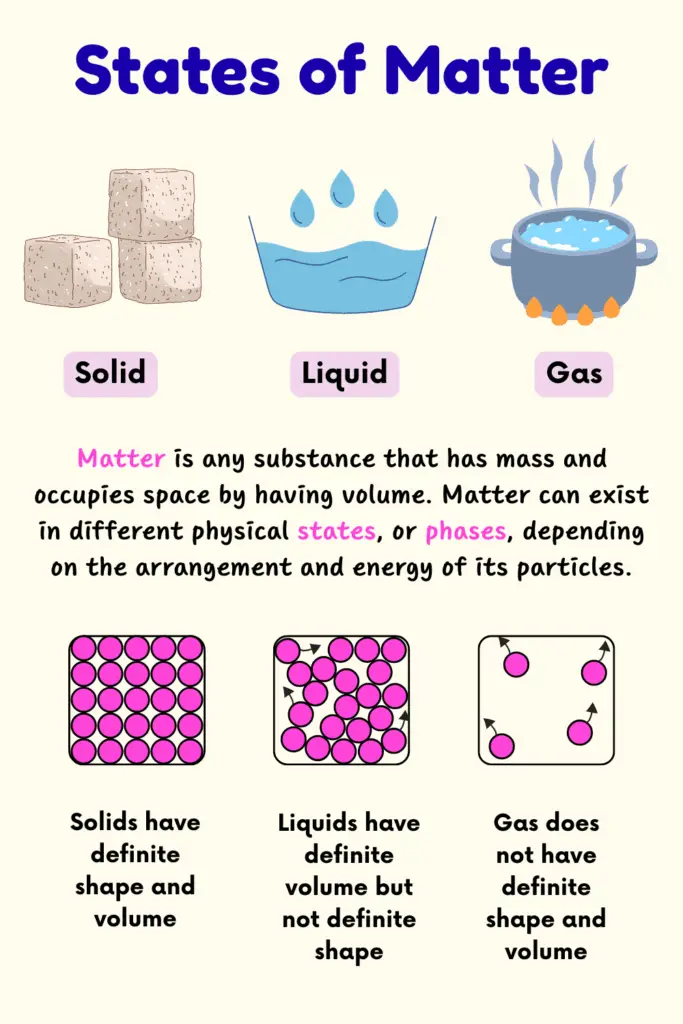Learning objectives
- Describe solids, liquids, gases using the particle model.
- Compare properties: shape, volume, density, compressibility, diffusion, and energy.
- Explain changes of state and factors affecting them (temperature, pressure).
- Distinguish evaporation from boiling and outline basic gas-law relations.
What is matter?
- Matter is anything that has mass and occupies space. It is made of particles (atoms/molecules) that are in continuous motion.
- The observable properties of a substance depend on particle arrangement, the strength of intermolecular forces, and kinetic energy of particles.
Particle model: core ideas
- Particles attract each other with intermolecular forces; stronger forces hold particles closer and more orderly.
- All particles move; higher temperature means higher average kinetic energy and faster motion.
- Space between particles varies across states: smallest in solids, largest in gases.
Differences between states of matter
Solids
- Fixed shape and fixed volume.
- Particles are closely packed in an orderly arrangement; vibrate about fixed positions.
- Strong intermolecular forces.
- High density (generally), negligible compressibility.
- Very slow diffusion (practically negligible).
- Examples: ice, iron, wood.
Liquids
- No fixed shape; take the shape of the container. Fixed volume.
- Particles are close but can slide past one another.
- Intermediate intermolecular forces.
- Moderate density, very low compressibility.
- Diffuse slowly (faster than solids but slower than gases).
- Examples: water, oil, alcohol.
Gases
- No fixed shape or volume; fill the entire container.
- Particles are far apart; move randomly and rapidly in all directions.
- Very weak intermolecular forces.
- Low density, highly compressible.
- Diffuse rapidly and mix uniformly.
- Examples: air, oxygen, carbon dioxide.
Beyond the basics
- Plasma: Ionized gas with free electrons and ions; conducts electricity and responds to magnetic fields. Found in stars, neon signs, flames.
- Bose–Einstein condensate (BEC): Matter at ultra-low temperatures where many atoms occupy the lowest energy state, behaving as a single quantum entity.
Change of state
- Melting (fusion): Solid – liquid at melting point; heat increases particle energy, weakening forces so particles can move past each other.
- Freezing (solidification): Liquid – solid; particles lose energy and arrange into an ordered structure.
- Vaporization (boiling): Liquid – gas throughout the liquid at boiling point; forms bubbles; requires heat.
- Condensation: Gas – liquid upon cooling or compression.
- Evaporation: Surface liquid molecules escape to gas below boiling point; occurs at all temperatures.
- Sublimation: Solid <–> gas directly (e.g., dry ice, naphthalene).
- Latent heat: Energy absorbed or released during change of state at constant temperature. For mass $m$, heat $Q$ is $Q = mL$, where $L$ is latent heat (of fusion or vaporization).
Evaporation vs boiling
- Evaporation occurs at the surface, at any temperature, is slower, and causes cooling (high-energy particles escape first).
- Boiling occurs throughout the liquid, at a fixed boiling point, is rapid, and needs continuous heat.
Factors increasing evaporation:
- Higher temperature.
- Larger surface area.
- Lower humidity.
- Faster airflow.
- Lower atmospheric pressure.
Effect of temperature and pressure
- Increasing temperature raises particle kinetic energy, promoting melting, evaporation, and faster diffusion.
- Increasing pressure pushes particles closer:
- Raises boiling point of liquids.
- Can condense gases to liquids.
- Reduces gas volume significantly.
Everyday applications and examples
- Solid ice melting into water and boiling into steam illustrates all three core states.
- Perfume smell spreading quickly demonstrates fast diffusion in gases.
- Clothes drying faster on a windy, hot day illustrates evaporation factors.
- Pressure cookers raise boiling point, cooking food faster.
- LPG cylinders store gas as a liquid under pressure; it vaporizes on release.
Common misconceptions
- “Solids do not have moving particles.” Incorrect; particles vibrate about fixed positions.
- “Evaporation needs the liquid to be hot.” It occurs at all temperatures, though faster when hotter.
- “Gases have no mass.” Gases have mass and exert pressure.
- “Boiling and evaporation are the same.” They differ in location (surface vs bulk) and conditions.
Quick check questions
- Why are gases highly compressible while solids are not?
- List two factors that increase evaporation and explain the particle-level reason.
- State one practical use of increasing pressure to change the state of matter.
- How does diffusion rate compare among solids, liquids, and gases, and why?
- What happens to the boiling point of water at high altitudes and why?
Revision table
| Property | Solid | Liquid | Gas |
|---|---|---|---|
| Shape | Fixed | Not fixed (takes container’s shape) | Not fixed (fills container) |
| Volume | Fixed | Fixed | Not fixed |
| Particle arrangement | Closely packed, ordered | Close, disordered, sliding | Far apart, random |
| Particle motion | Vibrate about fixed positions | Slide/flow past each other | Rapid, random, straight-line between collisions |
| Intermolecular forces | Strong | Intermediate | Very weak |
| Density (relative) | High | Moderate | Low |
| Compressibility | Negligible | Very small | High |
| Diffusion rate | Extremely slow | Slow | Fast |
| Energy (kinetic) | Lowest | Higher than solids | High |
| Typical examples | Ice, metals, rock | Water, oil, mercury | Air, oxygen, $CO_2$ |
| Key processes to change state | Melting, sublimation | Freezing, boiling, evaporation | Condensation |
Share it
